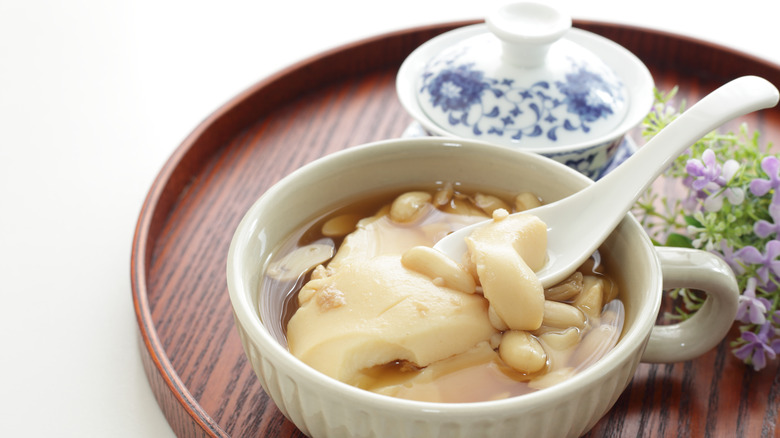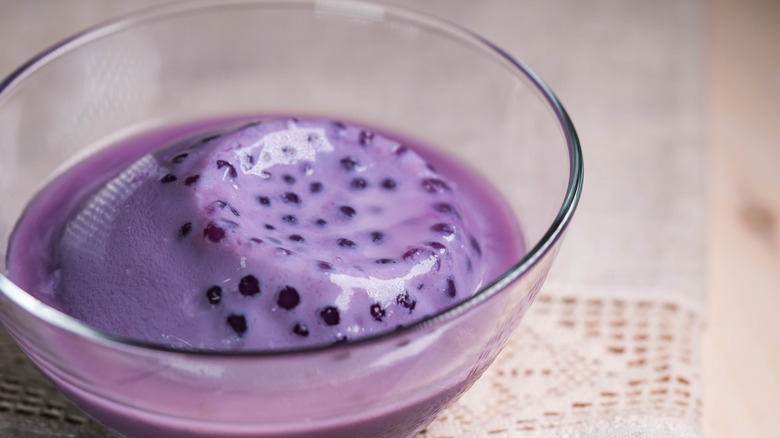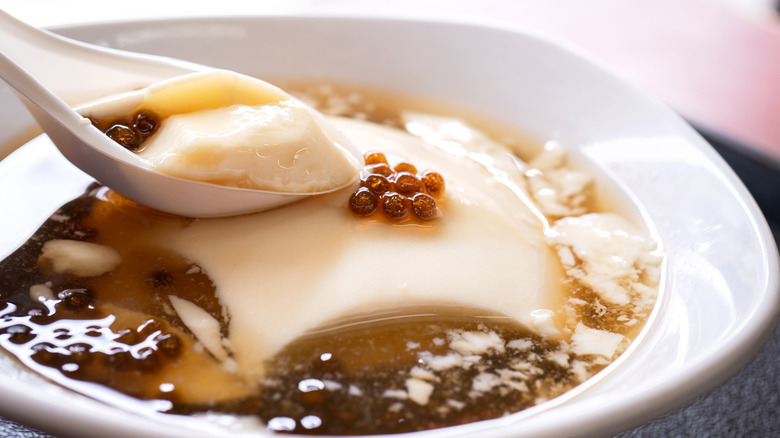Douhua Is The Ultra-Soft Tofu Pudding You Need To Know
Strolling through a bustling night market, you encounter a Chinese vendor selling something akin to tofu, but sweet and cold and even adorned with boba and dark syrup. Of course, your curiosity piques. Tofu as a dessert? Welcome to the fascinating world of douhua, also known as doufuhua (豆腐脑 or 豆腐花), a popular and time-tested Chinese delicacy of a dessert that showcases the incredible versatility of humble tofu. Douhua is a soft and silky tofu dish beloved across Asia and especially China, albeit with regional variations.
The name translates to "flower of the soybean" or "tofu flower," alluding to the way it spreads and floats with a silky texture, much like flower petals in sweet syrup. In Northern China, like Beijing, where it's referred to as doufunao or "tofu brain," you're more likely to encounter a savory drizzled with gravy and topped with mushrooms or a spicy variant complete with chili crisp oil, much like how congee is enjoyed for breakfast. Still, the douhau we're talking about is mostly sweet or not-too-sweet, though there's often something for every palate.
The evolving journey of douhua
Originating in China during the Han Dynasty, douhua carries a rich historical and cultural legacy. Various theories circulate about its origins, from failed attempts to create immortality pills to accidental discoveries involving boiling soybeans with sea salt. As Buddhism spread throughout Asia, this dish gained prominence and became a staple in many regions.
In Northern China, people enjoy douhua with soy sauce, while those in Sichuan prefer it with a kick of Sichuan peppercorns and spicy oil. The dish has also adapted to local tastes across Asia: in Indonesia, you'll find it spiced with ginger; in Taiwan, it may come with peanuts and boba; in Japan, it may include mochi; and in the Philippines—where locals know it as taho — it features toppings like sweet strawberry syrup, arnibal (or brown sugar syrup), and sago pearls. In the U.S., you can find traditional or modern takes on douhua, like boba-studded purple ones, rich with the flavors of taro or ube.
Originally a breakfast or dessert item, douhua has evolved to fit modern palates and schedules. Whether you prefer it adorned with trendy toppings like boba or classic ones like red bean paste, ginger, syrup, or honey, you can enjoy this versatile, fun, and delicious dish anytime.
There are many ways to make douhua at home
There are a few ways to make douhua at home. One could utilize a food hack and use gelatin or agar agar to thicken store-bought soy milk. Chill the mixture for a few hours after cooking the soy milk with the coagulant. The resulting douhua would be more jiggly and bouncy, akin to a mix of JELL-O and panna cotta. Another way to make douhua at home, following the traditional one more closely, is to use soybeans, glucono delta lactone (GDL), and cornstarch to make homemade tofu. The cooking process starts with soaking the soybeans for several hours, grinding them, straining them, and then boiling the resulting soy milk. The GDL and cornstarch, added to the soy milk, act as the coagulant, transforming the liquid soy milk into douhua's trademark custardy and silky soft texture after resting and chilling.
The easiest way, albeit unconventional, in our honest opinion, is to buy silken tofu from the supermarket, split it into heatproof serving bowls, heat them in the microwave, and serve with the toppings of your choice, like homemade syrup, honey, maple syrup, and sago, boba, strawberries, or a mix of everything you love. Your douhua can be sweet or savory (or sweet and savory); the only limit is your imagination and palate.


